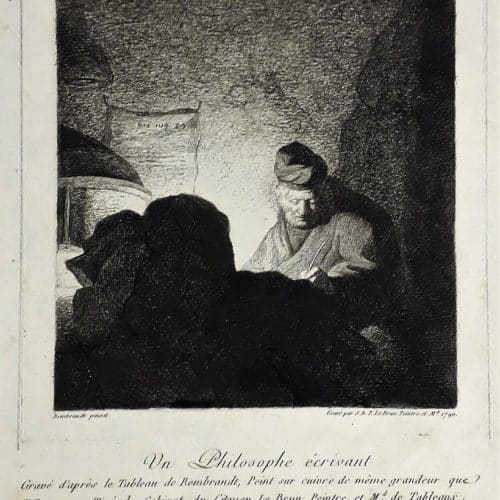Master Collection 21: Le Brun
A Philosopher Writing by Jean-Baptiste Pierre Le Brun (1748-1813) after Circle of Rembrandt van Rijn (1606-1669). Etching on paper.
It looks to be night-time in this picture. It’s dark in the room and there are deep shadows in the areas not lit by the single source of light.
The elderly man is writing. He holds a quill pen and is looking down to where his paper must be.
The name of the artist Rembrandt is written just below the image, on the left, and is mentioned in the longer text description below the image. The text below left of the image says ‘Rembrandt pinxit’ (Latin for ‘painted’); the text below right says ‘Gravé par J. B. P. Le Brun, Peintre et M[archan]d. 1790’ (French for ‘Etched by J[ean] B[aptiste] P[ierre] Lebrun, Painter and Merchant’).
The longer text description gives further explanation in French, meaning ‘A Philosopher Writing [écrivant], etched after the picture by Rembrandt, painted on copper of the same size as the print. Taken from the study/office of Citizen Le Brun, Painter and Picture Merchant/Art Dealer’.
Jean-Baptiste Pierre Le Brun was the son of a painter and art dealer, and began training as an artist. However, when his father died before the training was complete, Le Brun gave up and took over his father’s business.
Like his father Le Brun specialised in work by Northern European - Dutch, Flemish and German - artists. He was especially fond of Rembrandt. Le Brun became the leading French expert and dealer in Northern European pictures and published important descriptive books. Our etching comes from Le Brun’s three-volume ‘Galerie des peintres flamands, hollandaise et allemands’ (1792-1794), which was illustrated with prints reproducing a selection of paintings. Some of the prints were made by Le Brun himself and some by other print-makers.
Many of the paintings illustrated were ones owned or sold by Le Brun. Our etching is unusual in being the same size as the original picture, which was a small oil painting on copper (instead of on canvas or wood panel). Most paintings were much larger than the prints that copied them.
At the time Le Brun made this etching, the original painting was believed to be by Rembrandt. Scholars have since decided that it was painted by someone else who was familiar with Rembrandt’s work - that is in his Circle.
The use of a light source like a candle to illuminate parts of figures emerging from dark surroundings was something Rembrandt was very fond of. He was also a master of painting and drawing old age.
Le Brun calls himself ‘Citoyen’ (Citizen) because he made this print in 1790 during the French Revolution. He had been a royalist, like his wife Elisabeth Vigée Le Brun (1755-1842), who painted portraits of French queen Marie Antoinette. When revolution broke out in 1789, Elisabeth Vigée Le Brun fled to Italy with their young daughter. Le Brun stayed in Paris and, as the situation changed, distanced himself from his wife and divorced her. He occupied himself with publication of his three-volume illustrated ‘Galerie’ and managed somehow to avoid being sent to the guillotine.
His expertise was called upon when a national museum was planned in France, which became the Musée Napoleon. Le Brun was put in charge of selecting and describing art works for the museum that had previously belonged to now-disgraced or executed aristocrats. After the period of Terror he had campaigned for his ex-wife to be removed from the list of counter-revolutionary emigres and in 1802 she was able to return to France, having spent time in Austria and Russia after Italy.

